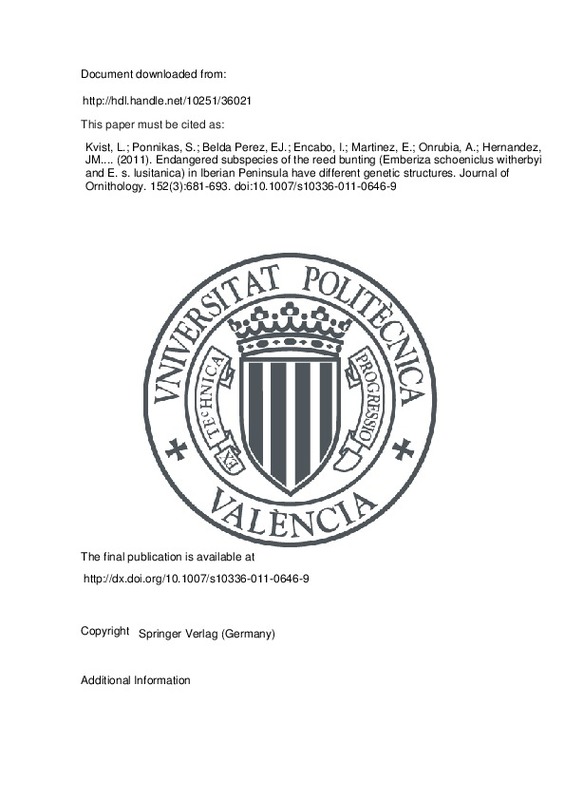Atienza JC, Copete JL (2004) Escribano palustre iberoriental/escribano palustre iberoccidental. In: Madroño A (ed) Libro rojo de las aves de España Ministerio de Medio Ambiente, Madrid, pp 378–379
Belda EJ, Encabo JL, Hernández JM et al (2008) Requerimientos y uso del hábitat del escribano palustre iberoriental Emberiza schoeniclus witherbyi. In: Barba E, Monrós JS, Belda EJ, Andreu J (eds) XII Congreso Nacional y IX Iberoamericano de Etología Ponencias y comunicaciones. Publicaciones de la Universidad de Valencia, Valencia, p 67
Bensch S, Price T, Kohn J (1997) Isolation and characterization of microsatellite loci in a Phylloscopus warbler. Mol Ecol 6:91–92
[+]
Atienza JC, Copete JL (2004) Escribano palustre iberoriental/escribano palustre iberoccidental. In: Madroño A (ed) Libro rojo de las aves de España Ministerio de Medio Ambiente, Madrid, pp 378–379
Belda EJ, Encabo JL, Hernández JM et al (2008) Requerimientos y uso del hábitat del escribano palustre iberoriental Emberiza schoeniclus witherbyi. In: Barba E, Monrós JS, Belda EJ, Andreu J (eds) XII Congreso Nacional y IX Iberoamericano de Etología Ponencias y comunicaciones. Publicaciones de la Universidad de Valencia, Valencia, p 67
Bensch S, Price T, Kohn J (1997) Isolation and characterization of microsatellite loci in a Phylloscopus warbler. Mol Ecol 6:91–92
Byers C, Olsson U, Curson J (1994) Buntings and Sparrows—a guide to the Buntings and North American Sparrows. Pica Press, Sussex
Caughley G (1994) Directions in conservation biology. J Anim Ecol 63:215–244
Clement M, Posada D, Crandall KA (2000) TCS: a computer program to estimate gene genealogies. Mol Ecol 9:1657–1660
Cornuet JM, Luikart G (1996) Description and power analysis of two tests for detecting recent population bottlenecks from allele frequency data. Genetics 144:2001–2014
Cramp S, Perrins CM (1994) The birds of the western palearctic, vol 9. Oxford University Press, Oxford
Crandall KA, Bininda-Edmonds ORP, Mace GM, Wayne RK (2000) Considering evolutionary processes in conservation biology. Trends Ecol Evol 15:290–295
Excoffier L, Smouse PE, Quattro JM (1992) Analysis of molecular variance inferred from metric distances among DNA haplotypes: application to human mitochondrial DNA restriction data. Genetics 131:479–491
Fraser DJ, Bernatchez L (2001) Adaptive evolutionary conservation: towards a unified concept for defining conservation units. Mol Ecol 10:2741–2752
Garza JC, Williamson EG (2001) Detection of reduction in population size using data from microsatellite loci. Mol Ecol 10:305–318
Graputto A, Pilastro A, Marin G (1998) Genetic variation and bill size dimorphism in a passerine bird, the reed bunting Emberiza schoeniclus. Mol Ecol 7:1173–1182
Griffith SC, Stewart IRK, Dawson DA et al (1999) Contrasting levels of extra-pair paternity in mainland and island populations of the house sparrow (Passer domesticus): is there an’island effect’. Biol J Linn Soc 68:303–316
Hanotte O, Zanon C, Pugh A et al (1994) Isolation and characterization of microsatellite loci in a passerine birds: the reed bunting Emberiza schoeniclus. Mol Ecol 3:529–530
Hey J, Waples RS, Arnold ML et al (2003) Understanding and confronting species uncertainty in biology and conservation. Trends Ecol Evol 18:597–603
Keane TM, Naughton TJ, McInerney JO (2007) MultiPhyl: A high throughput phylogenomics webserver using distributed computing. Nucl Acids Res 35:W33–W37
Kuhner MK (2006) Lamarc 20: maximum likelihood and Bayesian estimation of population parameters. Bioinformatics 22:768–770
Kvist L, Martens J, Higuchi H et al (2003) Evolution and genetic structure of the great tit (Parus major) complex. Proc R Soc Lond B 270:1447–1454
Lande R (1988) Genetics and demography in biological conservation. Science 241:1455–1460
Matessi G (1999) Evolutionary patterns in European populations of reed bunting (Emberiza schoeniclus ssp). Dissertation, University of Bologna
Mayer C, Schiegg K, Pasinelli G (2008) Isolation, characterization and multiplex genotyping of 11 autosomal and four sex-linked microsatellite loci in the reed bunting, Emberiza schoeniclus (Emberizidae, Aves). Mol Ecol Notes 8:332–334
Moritz C (1994) Defining evolutionary significant units for conservation. Trends Ecol Evol 9:373–375
Ovenden J, Peel D, Street R, Courtney A, Hoyle S et al (2007) The genetic effective and adult census size of an Australian population of tiger prawns (Penaeus esculentus). Mol Ecol 16:127–138
Patkeau D (1999) Using genetics to identify intraspecific conservation units: a critique of current methods. Conserv Biol 13:1507–1509
Primmer CR, Møller AP, Ellegren H (1995) Resolving genetic relationships with microsatellite markers: a parentage testing system for the swallow Hirundo rustica. Mol Ecol 4:493–498
Pritchard JK, Stephens M, Donelly P (2000) Inference of population structure using multilocus genotype data. Genetics 155:945–959
Raymond M, Rousset F (1995) GENEPOP (version 12): population genetics software for exact tests and ecumenicism. J Hered 86:248–249
Rozas J, Rozas R (1999) DnaSP version 3: an integrated program for molecular population genetics and molecular evolution analysis. Bioinformatics 15:174–175
Ryder OA (1986) Species conservation and systematics: the dilemma of subspecies. Trends Ecol Evol 1:9–10
Sambrook J, Russell DW (2001) Molecular cloning: a laboratory manual, 3rd edn. Cold Spring Harbor Laboratory Press, New York
Spielman D, Brook BW, Frankham R (2004) Most species are not driven to extinction before genetic factors impact them. Proc Natl Acad Sci USA 101:15261–15264
von Oosterhout C, Hutchinson WF, Wills PM et al (2004) Micro-checker: software for identifying and correcting genotyping errors in microsatellite data. Mol Ecol Notes 4:535–538
Waples RS (1991) Pacific salmon, Onchorynchus spp, and the definition of species under the endangered species act. Mar Fish Rev 53:11–22
Zink RM, Barrowclough GF (2008) Mitochondrial DNA under siege in avian phylogeography. Mol Ecol 17:2107–2121
[-]







![[Cerrado]](/themes/UPV/images/candado.png)


